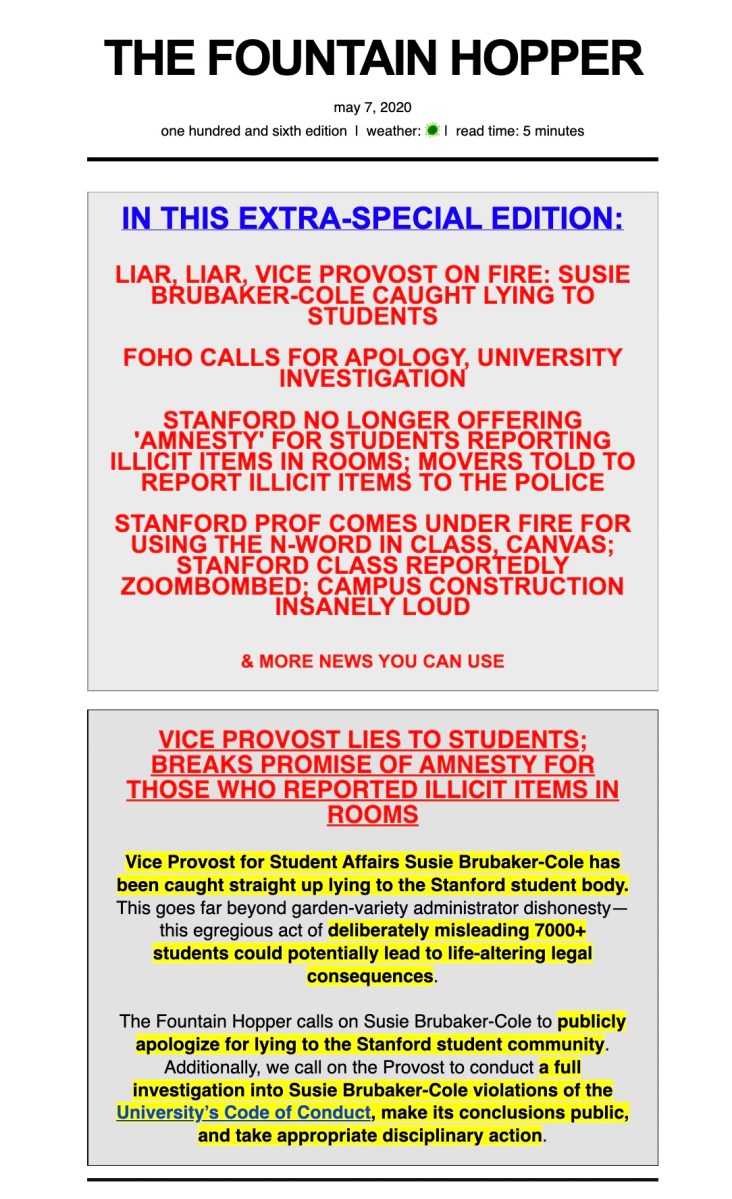Longtime members of the Stanford community will likely remember the anticipation felt when the latest Fountain Hopper (nicknamed the FoHo) digest arrived in their inboxes. The FoHo has investigated stories through crowdsourced tips, which are sometimes more akin to rumors. From breaking the news of Brock Turner’s sexual assault to administrative snafus, the FoHo has provided coverage of numerous Stanford scandals over the years.
The FoHo can be distinguished by its trademark form — each edition consists of long, digressive chunks of text. Titles are announced in a loud red and key details highlighted in bold and yellow. Content ranges from the salacious (inappropriate student-faculty relationships) to the saucy (dishonest administration).
Following intermittent newsletters during the pandemic, the publication appeared to go on hiatus after October 2021. Some students said they missed the interesting information provided by each email blast.
“It was exciting to see a new FoHo in my email. I never knew what to expect, but I knew it would be juicy,” said Daniella Lumkong ’23.
In a sudden return on Oct. 26, the FoHo sought candidates for a new editor-in-chief. It is unclear if a new one has been selected, but the FoHo has resurrected with recent editions 142 and 143.
Ilya Mouzykantskii ’16 founded the Fountain Hopper in September of 2014 with hopes of sharing tips and tricks for surviving college life. Its familiar moniker was derived from a burger served by The Axe and Palm (TAP) and the age-old Stanford tradition. In terms of subscribers, Mouzykantskii said the mailing list currently holds “low to mid five-digit numbers.”
To stir up conversation within the community, the FoHo regularly solicits tips from its readers. What started as a trickle of emails quickly turned into a deluge. Between 2014 and 2016, the influx of tips peaked at around a dozen per day, according to Mouzykantskii. During his tenure, he said that the staff size ballooned from one to 30 as the tasks of pruning out dead leads and fact-checking proved taxing.
The FoHo received tips from students, professors and administrators. As the publication’s reach grew, so did the grimness of these tips, which, Mouzykantskii said, granted “exposure to [the University’s] darker administrative underbelly.”
The watershed edition that branded the FoHo as a source for sensational news was FoHo #9. In this edition, the FoHo shared how a Kappa Sigma fraternity party went grossly awry with the arrival of “a professor with the garden shears,” a scenario Mouzykantskii described as simultaneously “hilarious but also quite serious.”
The blend of absurdity and severity helped cement the FoHo’s notoriety. In other special editions (exhibit one and exhibit two), the FoHo urgently advised students to request access to their FERPA records, to get ahold of personal data ranging from admissions files to all the doors at which one has ever swiped their SUID card. According to Mouzykantskii, these efforts succeeded in rousing around 3500 students to file requests.

Following these issues, the FoHo morphed into a seemingly reputable source for tabloid-esque stories, boasting email open rates of 80 to 90 percent, Mouzykantskii said.
The FoHo’s legacy may have been cemented in its sustained coverage of Chanel Miller’s story, including its initial breaking of the news. Mouzykantskii said he was most proud of the FoHo breaking this story and having “brought it to the national attention it deserved.” Emma Johanningsmeier ’18, who served as editor-in-chief during the 2017-2018 school year, covered reporting on the controversy surrounding the memorial plaque wording for Chanel Miller in FoHo #55, FoHo #56, FoHo #57 and FoHo #59.
In subsequent issues like FoHo #87, the FoHo pointed fingers at University administrators, implying their flagrant mishandling of the plaque installation, stating that if the plaque were not to be installed, it would “Fully prove to the student body that admins don’t give a single fuck about sexual violence.”
According to Johanningsmeier, writing for the FoHo did not come without its share of politics, immense pressure and heavy workload. Although she “didn’t take any pleasure in publishing negative stories about people,” the job often called for it, she said.
Mouzykantskii echoed this sentiment, saying that he “was summoned to see the Provost on many occasions.”
Johanningsmeier shared her fondness for the FoHo’s muckraking spirit, which is palpably woven through each issue. She said that even though the role’s anonymity made her “a little uneasy” since she could not explicitly take ownership for her words, it enhanced “the mystery and drama of the whole endeavor,” making it “kind of fun.”
Upon sending out her final issue, FoHo #66, she said “it was gratifying to finally sign my name and take responsibility for my work.” Mouzykantskii agreed and said “it was very exciting to be able to broadcast to such a tight and large community.”
At the end of each issue is a request for readers’ tips, of both the newsworthy and financial persuasions. The official website and older editions like FoHo #108 hammer in the FoHo’s reputation for guarding sources’ privacy and not using a penny of Stanford funding. These messages loftily proclaim that “When the admins come calling,” the FoHo “owes them nothing.” Per Mouzykantskii, donations to the FoHo help cover operating expenses including the MailChimp email service and Uber rides to the courthouse.
Financial independence from Stanford seems to have effectively granted the FoHo more freedom in their reporting. According to Johanningsmeier, given the immense “power imbalance between students and administrators,” the FoHo stood out as an entity “on the students’ side.”
Both Johanningsmeier and Mouzykantskii said there was a thrill to being “the publication that spoke truth to power,” trying to shed light on stories that Stanford tries sweeping under the rug.
Some students also appreciate the FoHo’s unrelenting self-sovereignty.
“By maintaining anonymity, the FoHo has been able to report on issues that The Daily and other news orgs wouldn’t for fear of administrative or social retribution,” said William Golub ’23, a member of the Flipside’s editorial board.
While The Daily “always works to prevent harm and consider the complete impact of all of our reporting on our community,” it would “never withhold truthful and important reporting for fear of administrative or social retribution, as we are an independent 501(c)(3) nonprofit” wrote Daily Editor-in-Chief Sam Catania in a statement. “This is most recently demonstrated by our continual coverage of research misconduct allegations against the most powerful person at Stanford: the president,” he added.
The FoHo has also confronted controversies during its eight-year existence. In one instance, the release of the problematic FoHo #68 precipitated the dismissal of the current editor-in-chief by Johanningsmeier. Numerous concerns were raised regarding this issue’s editorial decisions, including key witnesses not being asked for comment. Further sparking controversy is continued alumni involvement in FoHo in fields like appointing staff. Mouzykantskii said he “sit[s] on a board of former Fountain Hopper affiliates that participates in deciding who to pass on the mantle to on an annual basis.”
The FoHo has also faced scrutiny for at times imbuing facts with opinion. In a Daily Opinions piece, FoHo #93 was accused of containing misinformation, with the Daily piece rebutting the FoHo’s claims regarding a rise in phishing attacks at Stanford.
Although the FoHo’s style of news delivery is described by some as erratic and chaotic, some students savor this unsolicited nature.
“The FoHo is like your unfiltered uncle,” said Ben Nguyen ’23, referring to its tendency to share both random stories and criticisms. “That’s why it’s just so easy to love to hate it or just hate to love it!”
